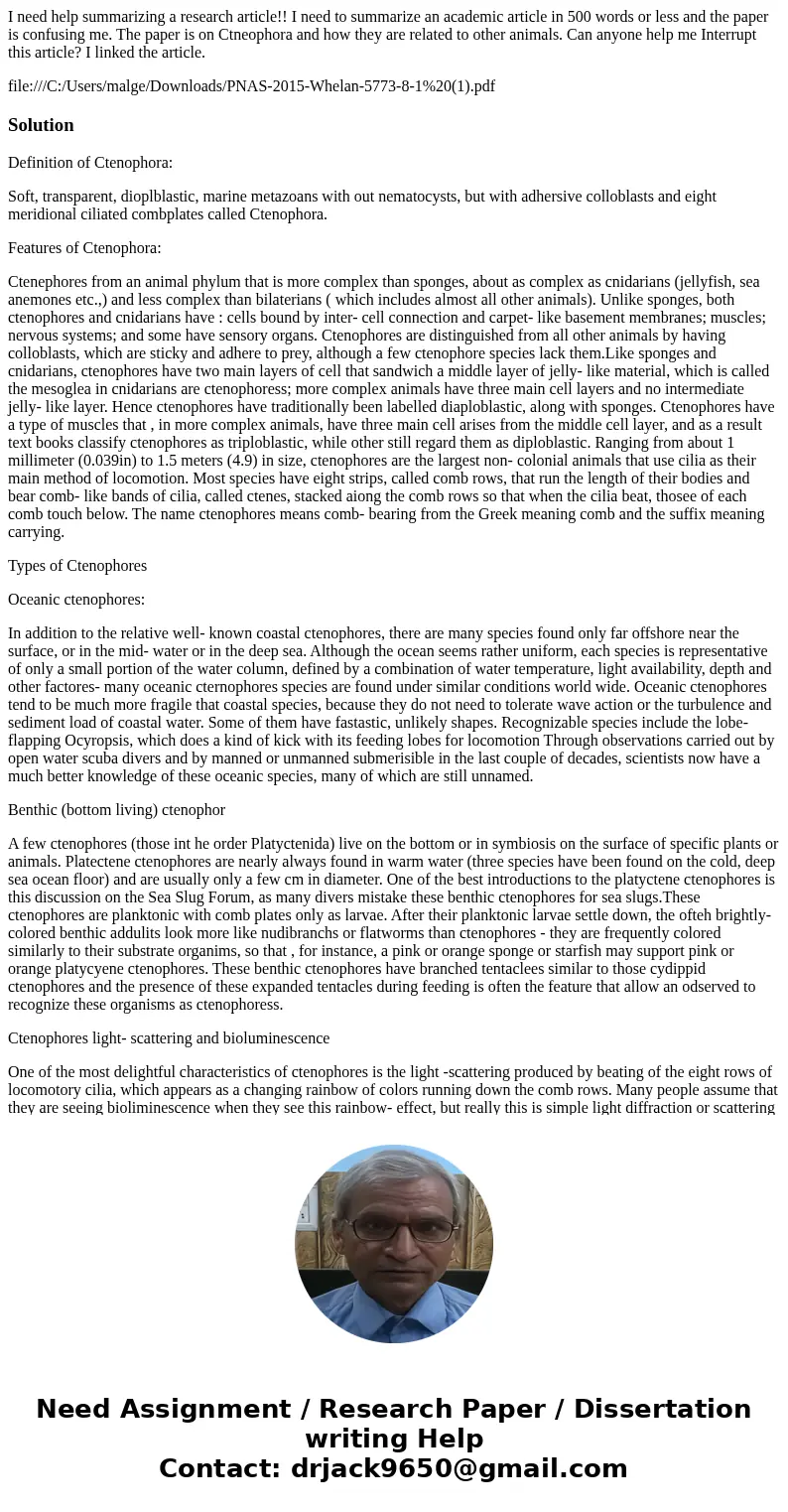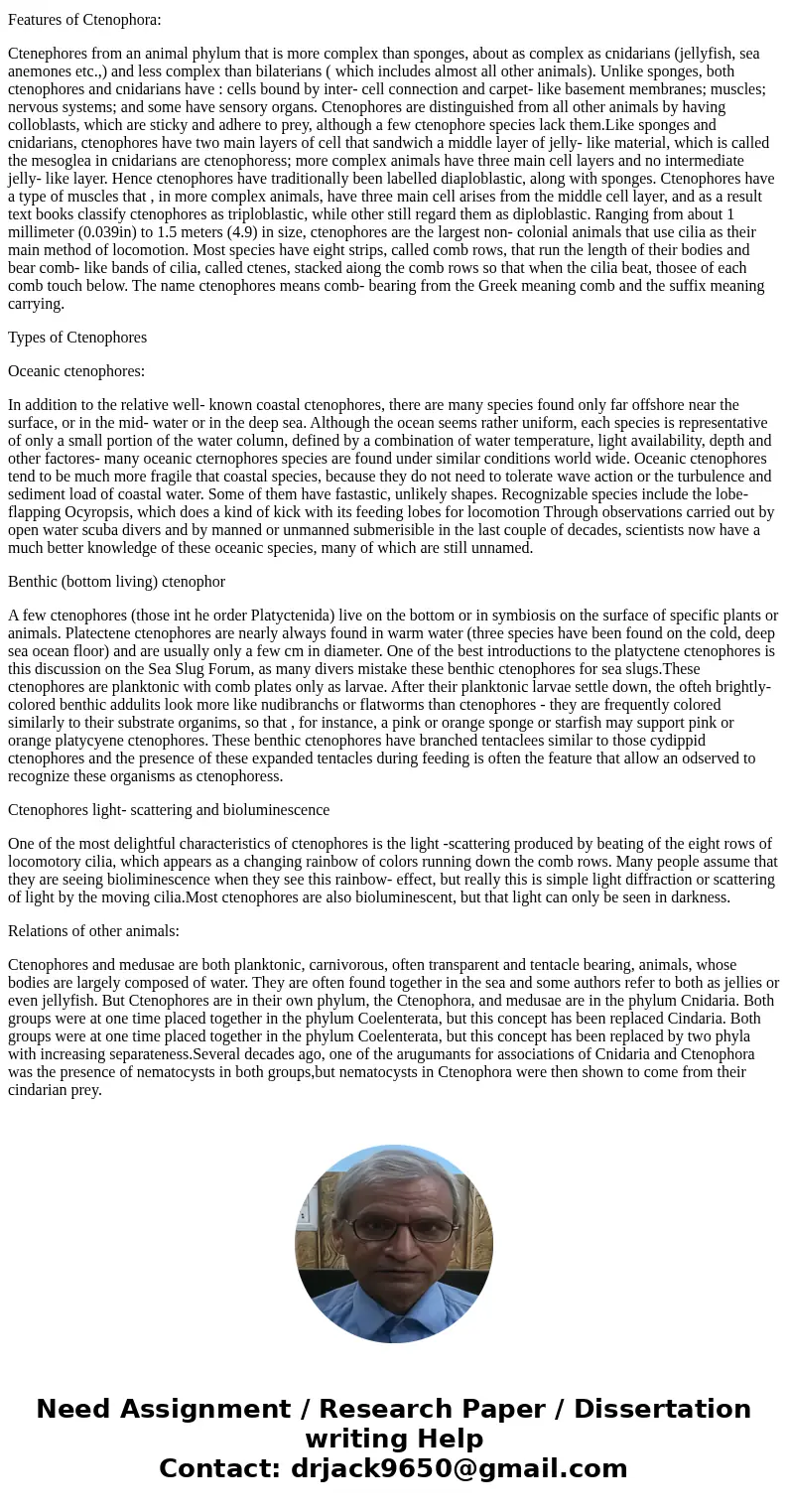I need help summarizing a research article I need to summari
I need help summarizing a research article!! I need to summarize an academic article in 500 words or less and the paper is confusing me. The paper is on Ctneophora and how they are related to other animals. Can anyone help me Interrupt this article? I linked the article.
file:///C:/Users/malge/Downloads/PNAS-2015-Whelan-5773-8-1%20(1).pdf
Solution
Definition of Ctenophora:
Soft, transparent, dioplblastic, marine metazoans with out nematocysts, but with adhersive colloblasts and eight meridional ciliated combplates called Ctenophora.
Features of Ctenophora:
Ctenephores from an animal phylum that is more complex than sponges, about as complex as cnidarians (jellyfish, sea anemones etc.,) and less complex than bilaterians ( which includes almost all other animals). Unlike sponges, both ctenophores and cnidarians have : cells bound by inter- cell connection and carpet- like basement membranes; muscles; nervous systems; and some have sensory organs. Ctenophores are distinguished from all other animals by having colloblasts, which are sticky and adhere to prey, although a few ctenophore species lack them.Like sponges and cnidarians, ctenophores have two main layers of cell that sandwich a middle layer of jelly- like material, which is called the mesoglea in cnidarians are ctenophoress; more complex animals have three main cell layers and no intermediate jelly- like layer. Hence ctenophores have traditionally been labelled diaploblastic, along with sponges. Ctenophores have a type of muscles that , in more complex animals, have three main cell arises from the middle cell layer, and as a result text books classify ctenophores as triploblastic, while other still regard them as diploblastic. Ranging from about 1 millimeter (0.039in) to 1.5 meters (4.9) in size, ctenophores are the largest non- colonial animals that use cilia as their main method of locomotion. Most species have eight strips, called comb rows, that run the length of their bodies and bear comb- like bands of cilia, called ctenes, stacked aiong the comb rows so that when the cilia beat, thosee of each comb touch below. The name ctenophores means comb- bearing from the Greek meaning comb and the suffix meaning carrying.
Types of Ctenophores
Oceanic ctenophores:
In addition to the relative well- known coastal ctenophores, there are many species found only far offshore near the surface, or in the mid- water or in the deep sea. Although the ocean seems rather uniform, each species is representative of only a small portion of the water column, defined by a combination of water temperature, light availability, depth and other factores- many oceanic cternophores species are found under similar conditions world wide. Oceanic ctenophores tend to be much more fragile that coastal species, because they do not need to tolerate wave action or the turbulence and sediment load of coastal water. Some of them have fastastic, unlikely shapes. Recognizable species include the lobe- flapping Ocyropsis, which does a kind of kick with its feeding lobes for locomotion Through observations carried out by open water scuba divers and by manned or unmanned submerisible in the last couple of decades, scientists now have a much better knowledge of these oceanic species, many of which are still unnamed.
Benthic (bottom living) ctenophor
A few ctenophores (those int he order Platyctenida) live on the bottom or in symbiosis on the surface of specific plants or animals. Platectene ctenophores are nearly always found in warm water (three species have been found on the cold, deep sea ocean floor) and are usually only a few cm in diameter. One of the best introductions to the platyctene ctenophores is this discussion on the Sea Slug Forum, as many divers mistake these benthic ctenophores for sea slugs.These ctenophores are planktonic with comb plates only as larvae. After their planktonic larvae settle down, the ofteh brightly- colored benthic addulits look more like nudibranchs or flatworms than ctenophores - they are frequently colored similarly to their substrate organims, so that , for instance, a pink or orange sponge or starfish may support pink or orange platycyene ctenophores. These benthic ctenophores have branched tentaclees similar to those cydippid ctenophores and the presence of these expanded tentacles during feeding is often the feature that allow an odserved to recognize these organisms as ctenophoress.
Ctenophores light- scattering and bioluminescence
One of the most delightful characteristics of ctenophores is the light -scattering produced by beating of the eight rows of locomotory cilia, which appears as a changing rainbow of colors running down the comb rows. Many people assume that they are seeing bioliminescence when they see this rainbow- effect, but really this is simple light diffraction or scattering of light by the moving cilia.Most ctenophores are also bioluminescent, but that light can only be seen in darkness.
Relations of other animals:
Ctenophores and medusae are both planktonic, carnivorous, often transparent and tentacle bearing, animals, whose bodies are largely composed of water. They are often found together in the sea and some authors refer to both as jellies or even jellyfish. But Ctenophores are in their own phylum, the Ctenophora, and medusae are in the phylum Cnidaria. Both groups were at one time placed together in the phylum Coelenterata, but this concept has been replaced Cindaria. Both groups were at one time placed together in the phylum Coelenterata, but this concept has been replaced by two phyla with increasing separateness.Several decades ago, one of the arugumants for associations of Cnidaria and Ctenophora was the presence of nematocysts in both groups,but nematocysts in Ctenophora were then shown to come from their cindarian prey.


 Homework Sourse
Homework Sourse